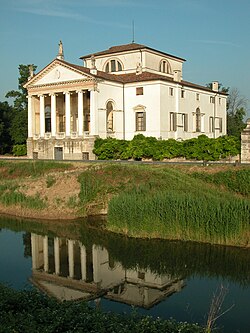Villa Molin

Villa Molin is a patrician residence in the neighborhood of Mandria, in
History

The plot of land, comprising fifty-two fields lying between Mandria and Abano Terme, was in the possession of Donna Elena, widow of Vincenzo Molin, in 1582. When Nicolò wished to erect there a villa for summer use that would be suited to the family's standing, it was natural to turn to Scamozzi, first among Venetian architects in the terraferma since the death of Palladio in 1580.
The villa was rapidly completed but not long enjoyed by its patron, who died on 9 May 1608. Seven years later his brothers conveyed the villa to Pio Capodilista; it passed to his son Annibale, then to the heirs of Annibale's sister Sigismonda. Alienated from the
During
Building

The
The villa's other façades are simply treated and harmoniously symmetrical, with central
Notes
- James I of England. His official correspondence with the Serenissima, in the Calendar of state papers relating to English affairs in the archives of Venice, have long been mined by historians.
- ^ Scamozzi was responsible for the completion of the Villa after Palladio's death, and designed the low central dome modelled on that of the Pantheon with a central oculus
- ^ See Rudolf Wittkower, Architectural Principles in the Age of Humanism, The Warburg Institute, London, 1949.
References
- Bové, Valeria (1999). Ville Venete (in Italian). Venice: Arsenale. ISBN 88-7743-200-4.
External links
- Villa Molin: la storia (in Italian)
- Relazioni dall'Inghilterra: Nicolò Molin (1607) Nicolò Molin's report of his embassy to London. (Italian)
